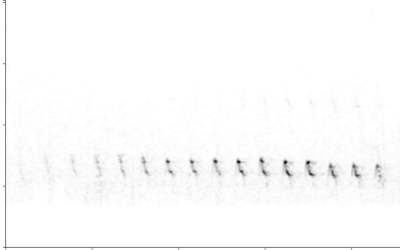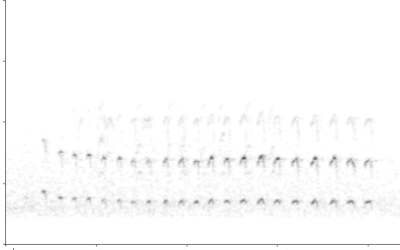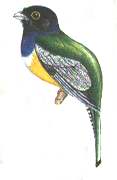

Click on spectrogram to download sound file
Click on spectrogram to download sound file

 |
 |
| Violaceous
Trogon song - Neuva Becal
Click on spectrogram to download sound file |
Violaceous
Trogon whisper song - Calakmul
Click on spectrogram to download sound file |
![]()
Song Description:
The song of the Violaceous Trogon is a repeated series of hollow whistles, much like the call of the Ferruginous Pygmy-owl only shorter in total length and higher in average pitch.
The whisper song is extremely quiet (ie. the above recording was made when the trogon was less than four meters from the tip of my microphone with the recording level set to maximum) and as such, this song is not often heard and is poorly described. The whisper song is superficially similar to the full song, albeit much lower in amplitude.
Stiles and Skutch (1989) also describe an alarm note and a nasal "nyrrrro" which is usually accompanied by pumping tail movements.
![]()
Song Measures:
The full song is a series of 12 to 20 evenly-spaced and gradually descending whistled syllables given at a rate of approximately four per second. Each syllable typically has a bandwidth of 500 Hz, and they descend from a maximum of 1500 Hz to a maximum of 1300 Hz as the song progresses (N = six songs from two individuals).
Although superficially similar to the full song, the whisper song's syllables are given much more quickly and the song is lower in pitch. A series of 10 to 20 evenly-spaced syllables (mean = 16.3 ± 3.5) are given at an average rate of 5.8 ± 0.24 syllables per second. Each syllable has a bandwidth of approximately 100 Hz, and consecutive syllables descend from a maximum of 850 Hz to a maximum of 700 Hz. Prominent overtones occur at 1250 to 1500 Hz, while subtle overtones occur at 1950 to 2100 Hz.
![]()
Singing Behaviour:
Full songs were heard most often in the early to mid morning, from high within a thick canopy. On two occasions I encountered a Violaceous Trogon and a Squirrel Cuckoo (Piaya cayana) singing from within the same tree, almost as though they were singing back and forth. (A Squirrel Cuckoo can be heard behind the second song in the example above.) Twice I heard a trogon sing very short songs of three or four syllables, followed by a very short pause, and then a full song.
I recorded the whisper song from a bird who sat perched a few meters from the ground in a fairly open canopy in the late afternoon. The singer preened through the entire song bout, and no other trogons were detected nearby. Given the low amplitude of this signal, we may assume that this vocalization functions only in very short range communication.
![]()
Habitat:
Violaceous Trogons were typically found in the thickest parts of second-growth forest, often five to fifteen meters up in the canopy, and were occasionally seen at forest edges.
![]()
Return
to Bird Songs of the Yucatan Main Page
All
information and photographs copyright Daniel J. Mennill 1999.
No recordings or other information from this site may be used without
written permission from me.
Please email me (dmennill AT
uwindsor DOT ca) and I will happily grant permission for any
non-commercial or education purposes.